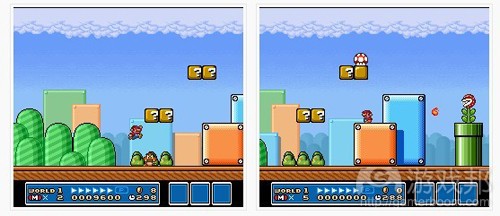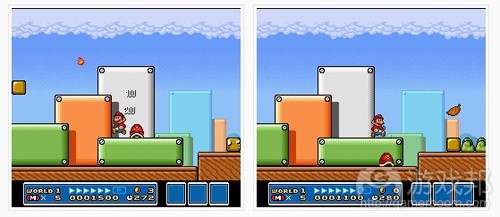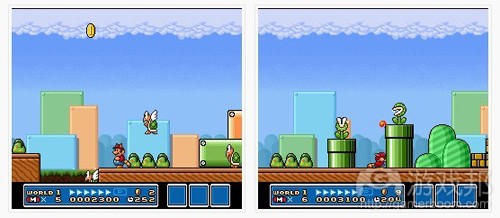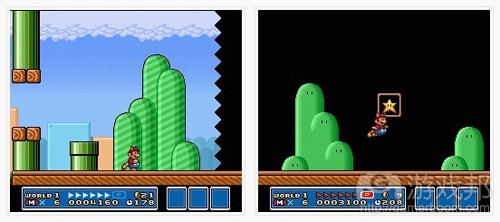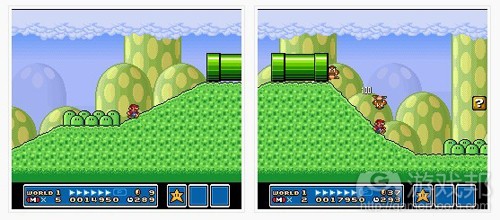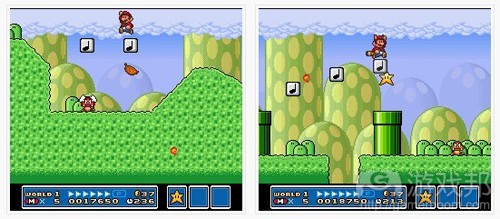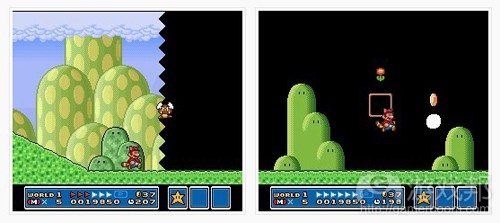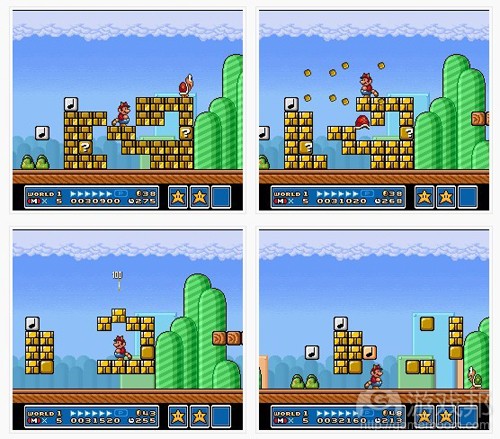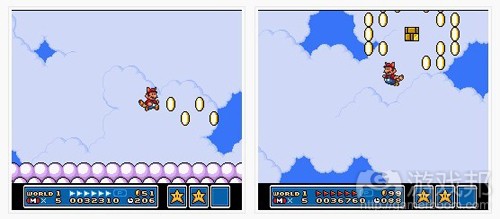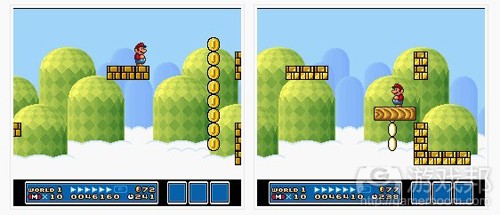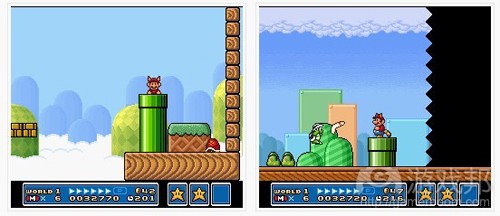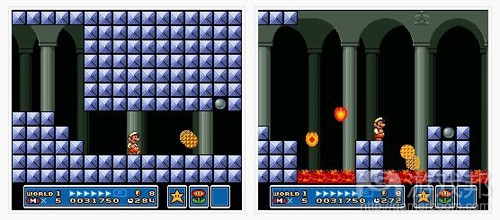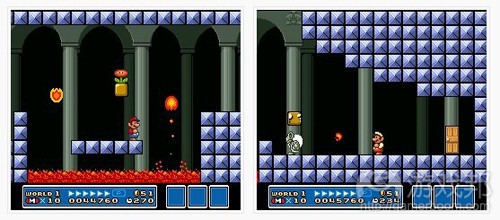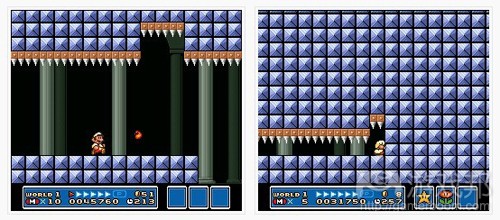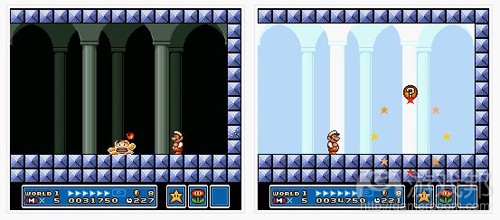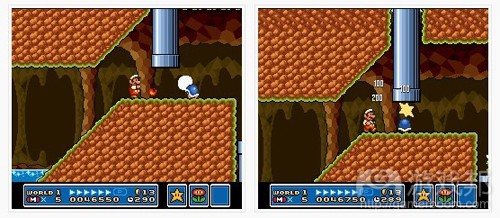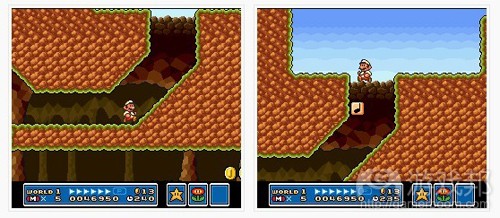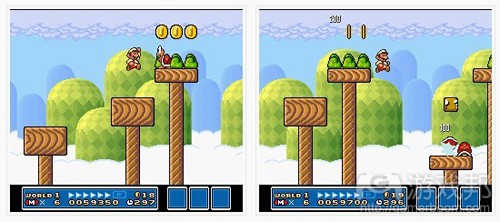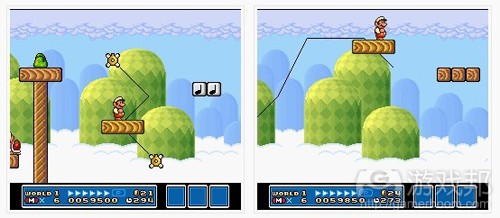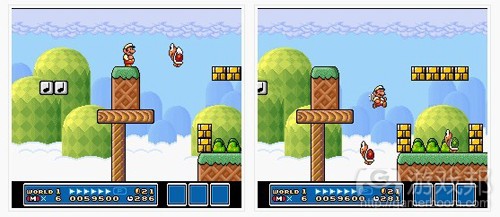解析《超级马里奥兄弟3》关卡设计经验
作者:Radek Koncewicz
我想,很多再次玩游戏的玩家都会因为掌握了游戏机制而快速略过一些环节,直接跃到最后的游戏世界中。这就意味着他们可能会因此错过一些精心设计的游戏关卡。虽然我也有这种游戏习惯,但是这次我决定完整地体验《超级马里奥兄弟3》(游戏邦注:以下简称SMB3)。
虽然在后面世界中还有许多小型且类似于几何体的游戏关卡,我想先在本文中概述首个游戏世界中最引人注意的要点:
1)世界1-1
与之前的《超级马里奥兄弟》系列相同,游戏一开始便会出现“?”方块,通过使用最为普遍的问号标志能够帮助游戏更好地吸引玩家的好奇。
除了马里奥需要用头去撞击这些方块,同时他们还需要提防碰触到慢慢向其靠近的“Goomba”,在此跳跃,撞击方块然后获得奖励(游戏邦注:在这里指的是“金币”和“Super Mushroom”)。
在这里也会出现《马里奥》游戏中经典的红色“Venus Fire Trap”——被摧毁后不会复生,并且只会在马里奥远离管道(或者跳到管道上)时才会出现。尽管玩家不能够沿着这种特殊管道下降到其它关卡,但是当他们看到敌人从管道中出现便会猜测自己是否也能够这么做。
2)世界1-1
收集了蘑菇道具后玩家会遇到红色的“Koopa Troopa”,在马里奥跳起来攻击它后,便会发现龟壳下隐藏着敌人。
在被马里奥攻击之后,“Koopa Troopa”便会快速远离他。尽管在这里会出现一个很大的白色框,但是玩家也能够轻易地通过它。如此他会发现自己可以跳到“Koopa Troopa”的壳上去激活“?”框(因为在这里马里奥直接跳跃并不能勾着这个方框,所以这是唯一的一种方法),并因此发现游戏中另一种新的道具“Super Leaf”。
然后玩家将继续往右走,前面是一条平坦的道路,然后会出现3个敌人,其中一个便是红色的“Paragoomba”,在这里玩家可以体验到Raccoon Mario的滑行和旋转攻击机制。
3)世界1-1
在经过了三个“Goomba”(被消灭后不会复生)后,天空中会出现连成对角线排列着的金币。玩家需要越过这条道路尽头的一个无底深渊,然后尽可能地往高处跳跃去收集这些金币。
当玩家开始奔跑时,HUD仪表便会填满,而背景动画也会发生改变,并会循环播放一个节奏急凑的音乐。这些都是为了凸显某些重要时刻的出现,而当玩家跳跃并在空中翱翔之时,屏幕(这是《马里奥》游戏首次出现的场景)便会同时出现纵向和横向的滚动。
4)世界1-1
当马里奥跳到云层上时,他会发现漂浮在天上的独立砖墩,就像是地上的“?”块。而玩家也可以用同样的方法跳起撞击砖墩,如此获得“1-Up Mushroom”(游戏邦注:绿色蘑菇标志,让玩家能够获得额外的生命)。
继续往右走,将是一条布满一连串金币的道路。看到了如此多的金币,玩家将会大胆地豁出去,盲目地跳向未知的领域。不仅能够畅快地飞行,而且因为刚刚获得了额外的生命,所以玩家选择追逐这些额外宝藏也是合乎情理了。最后玩家将掉落在只有一个高管道的界面上。
因为在这里玩家已经无处可去了,如此更加突出了该管道的重要性。如果玩家知道如何进入管道,他便能够来到一个彩色的房间,房间中用金币罗列成一个字母3的字样。
5)世界1-1
如果玩家错过了跃上云道的机会,他们将会在接下来的两个部分中遇到一些新敌人。第一部分中会出现从空中掉落下来的绿色“Koopa Troopa”和3个绿色“Koopa Paratroopas”(这暗示着空中有些特别的内容)。
“Paratroopas”能够在平台上跳跃并下降,而两边的坑也意味着这些敌人自己也会掉落到其中而死亡。
第二个部分包含了一个“Piranha Plant”和一个绿色的“Venus Fire Trap”。这两个敌人的出现让马里奥不得不停下自己前进的脚步。而这时候玩家会发现,当自己靠近管道时,这两种植物便不会出现。这种不动的设置让玩家会为了躲避火球而发现蹲伏能力,而Raccoon Mario便能够用旋转攻击的方法消灭这些植物。
6)世界1-1
在这个关卡结束之前,玩家会遇到两个接地的砖堆。因为玩家之前曾经遇到过两次“Super Leaf”,所以他知道自己应该旋转攻击这些发光的目标体,并且他也不可能从地面上跳起碰触它们。
除此之外,玩家还会遇到单独的一只红色“Koopa Troopa”在第二个砖堆上踱步着。因为根据之前的游戏,玩家已经知道他们可以利用“Koopa Troopa”的外壳去攻击其它敌人并激活道具。而当他们这么做后,“Koopa Troopa”的外壳将会击破一堆砖墩,而只剩下一片坦荡的道路。如果马里奥是跳起撞击砖块(或者从旁边旋转攻击),那么在砖块上将会出现一个“P-Switch”。
“P-Switch”的功能是瞬间将所有剩下的砖块变成金币,并以倒计时的方式让玩家快速收集这些金币。而当倒计时结束后,剩下的砖块也会再次变成砖墩,以此告诉玩家这种福利只是暂时的。在这里音乐提示就变得异常重要,因为玩家不能通过任何视觉提示了解到砖块什么时候会恢复到最初形式。
7)世界1-1
这个关卡的最后将会出现一条黑色的锯齿状线,纵跨于整个屏幕。这条曲线是《超级马里奥兄弟》经常使用的一种关卡切换方法,因为它能够很清晰地告诉玩家一个关卡的结束。这种穿越主题界线的方法会让玩家有一种犹如踏进戏剧布帘中的感觉。
在这个阶段中玩家只需要面临一个目标,也就是动画式“Goal Panel”,并且当玩家碰触到它时,这个关卡便会结束。在这里玩家不会遇到其它障碍,所以他们只需要全速奔跑并跳向Panel即可。通常,Panel上所嵌有的奖励是一颗星星,这也是最佳的“Goal Panel”奖励。
8)世界1-2
第二个关卡一开始,玩家便会看到一个斜坡,然后开始体验马里奥攀爬斜坡的行动。当马里奥到达斜坡最高点时,他便能够发动旋转攻击打败Goomba,而在这里将会有越来越多Goomba从水平管中走出来。
9)世界1-2
这个关卡的第二大主要区域中会出现一些分布于空中且玩家难以够到的金币,一个漂浮在空中且带有“Venus Fire Trap”的管道,以及一些位于地面上方的砖墩。玩家有可能会尝试着收集更多的金币并打破砖墩,也有可能会采取奔跑躲避滑行的策略。
如果玩家先撞击第一个砖块,将会出现“P-Switch”。但是这个“P-Switch”与第一个关卡的不同,它功能是将所有的金币变成砖墩。这就使得金币会变成一条条道路帮助玩家通向管道。而这也标志着管道是玩家在此的最终目的地,以此将马里奥带到了另外一个布满金币的房间。
10)世界1-2
在这里将会出现关卡2中的一个新目标物,即“Jump Block”(游戏邦注:也成为音乐砖块,或弹性砖块,能够让马里奥跳得更高)。与其它砖块一样,这种砖块也有属于自己的独特外观,因此能够吸引玩家的关注。
最先出现的两个“Jump Block”分布在一个峡谷的上方,而下方便是一只“Paragoomba”,以此玩家能够跳到“Jump Block”上以避开或攻击敌人。这种砖块具有弹性,很容易让我们联想起蹦床或者松软的床,因此玩家能够立刻知晓它们的功能。
第二个砖块将会吐出一个道具,即玩家可以通过从下撞击或者降落在上方引出它,如果玩家错过了这个道具,那么画面将会继续发生转移,而下一片区域将会出现一个坑和一行呈现阶梯状的“Jump Block”。为了安全跃过这个坑,玩家必须利用“Jump Block”,并发现最后一个砖块下方会出现一颗“Starman”(吃了这颗星星马里奥便能够变成超级马里奥了)。
11)世界1-2
在这个关卡的最后将会出现一个新的敌人,即飞翔着的“Paragoomba”,它会不断地向马里奥投射“Micro-Goombas”。因为在这里不会出现其它敌人或者障碍物,所以可以很清晰地表现出“Micro-Goombas”落向马里奥的这种游戏机制。
如果玩家让“Paragoomba”跟着马里奥,他将会发现当马里奥碰触到“Goal Panel”时所有屏幕上的敌人便会立即死去。
12)世界1-3
在第三个关卡一开始玩家便会看到一些大型砖块以及一只“Koopa Troopa”。而这些元素似乎都是用来帮助玩家打败“Boomerang Bro”,就像玩家可以利用“Koopa Troopa”的壳去攻击它或者跳到高处的砖块上躲避它的“回飞棒”,并跳下去压扁它。
13)世界1-3
尾随着“Boomerang Bro”,玩家将会看到另外一堆砖墩以及一只红色“Koopa Troopa”,而玩家可以利用这只“Koopa Troopa”造成一系列连锁反应以破坏多余的砖块。这时候龟壳连续打破砖块让玩家更清楚地看到碰触“Jump Block”所带来的结果,并因此能够让他们得到一些额外的金币。
当龟壳离开后,玩家便可以沿着凹处下来,调查残余的砖块。其中有一个砖块能够吐出道具而另外一个能够制造金币。当玩家通过撞击砖块而创造了一个出口时马里奥便能够跳出来,而这时候他可能会碰到一个无形的“Jump Block”。这个粉色的砖块只能从下跳起撞击,而当它被激活时,马里奥便能够前往“Coin Heaven”收集更多金币。
14)世界1-3
尽管关卡3较为平坦,也就是障碍物较少,但是同时玩家能够收集的奖励也不多。但是玩家却可以选择可以进入“Cloud Heaven”收集更多金币甚至是“1-Up”。
15)世界1-3
在通过一堆砖墩后,玩家便会遇到一系列的“Wooden Blocks”(不能被挤破的砖块)。而这些砖墩之所以如此排序是想借此暗示玩家往前跳跃去按压它们,让他们发现通过侧面撞击也能够让这些砖块突出一些道具。
16)世界1-4
尽管第四个关卡并不是非常困难,但是比起前面3个关卡其挑战性明显增加了。在这里就不存在任何固定的地面了,而自动滚屏设置也会为玩家创造出一种紧张感。这就是为何玩家需要在上空不断跳跃的原因了。
马里奥除了会因为自动滚屏设置而死亡,也会受到移动平台的影响。这些平台只会水平移动,并在马里奥落在上面时开始下降。如此看来这是一个非常直观的游戏机制,因为马里奥的重量很容易压倒一个漂浮在空中的平台。
当玩家掌握了这一点后,他便可以利用移动平台的优势既收集金币又安全逃离该平台了。在经过快速思考之后,玩家便会跳到靠近的平台上,当它快速下降时他便可以收集垂直罗列的金币,而当平台下降到旁边砖块的缺口时,他也能够自然地进入这个缺口获得生存。这种机制能够很好地测试玩家对于环境的分析,并让他们感觉自己掌握了这种“横越”的能力。
17)世界1-4
与之前的关卡不一样,关卡4的结束面是一堵实体墙和一个管道。而因为已经无路可走了,玩家第一次面对穿越管道完成关卡的选择。另一方面,玩家也有可能受到“Boomerang Bro”的伏击,但最终还是能够找到标准的“Goal Panel”。
这里的游戏机制有点强调了关卡的选择性挑战属性,如果玩家收集到了屏幕上的所有金币,他便能够看到“Toad’s Blue House”(蘑菇型建筑,能够带给玩家意外的奖励)。
18)世界1 堡垒
首先出现在这里的是“Podoboo”(火球状)和“Roto-Disc”(火烙子棒状),并且玩家能够很容易地避开它们。但是当玩家掌握了它们的功能时,难度将会上升:从熔岩中将会出现更多Podoboo(不同时候),而Roto-Disc将会在平台上飘荡着,而马里奥就必须不断跳跃着去通过这个关卡。
19)世界1 堡垒
在这里将会出现堡垒中第一个升级道具–“Fire Flower”。这个道具非常重要,因为变身成“Fire Mario”的马里奥能够发出无人能及的火球攻击。这是游戏中多次使用到的一种战略,但是因为马里奥只要不被袭击就能够一直保持着“Fire Mario”的身份穿越不同关卡,并且因为“大型”马里奥拥有更大优势,所以这自然是一种有利因素。
20)世界1 堡垒
如果玩家选择用“Fire Flower”换取“Super Leaf”,他便能够发现隐藏在空中的另外一个秘密。空旷的天花板便暗示了这一点,而玩家可以跃起并重压在“Dry Bones”身上消灭他们,并向右奔跑。这个特殊的秘密便能够引导玩家找到“Warp Whistle”(游戏中极其稀有的道具,可以帮助玩家中游戏中间段快速跳跃到最后部分),这种方法比起让玩家为了获得第一个汽笛而延伸时间去躲避一些白色砖块的机制更加直观。
21)世界1 堡垒
玩家走入第一个门后便会进入拥有带刺天花板的房间。当玩家进入这块区域的时候天花板将会快速降落,但是其中有一个缝隙能够让马里奥逃生。因为玩家找不到其它办法,所以只能在天花板将自己压碎之前奋力奔向缝隙中。
当天花板全部降落下来时,它便会开始往后退,而马里奥则不得不跳进一个无底深渊中。这时候玩家看不到任何躲藏处,而他只能相信游戏会帮助他。这就创造了一种紧张感,并强迫玩家充满信念,而最后他也会因为天花板最后的一道缺口获救(比起第一块缺口明显小得多)。因为这个缺口就在墙壁旁边,所以玩家很容易能够钻进去,但是因为过小的空间让玩家在逃跑时会更显紧张与无助。
22)世界1 堡垒
堡垒关卡的结尾是马里奥必须与“Boom Boom”展开对决,他必须连续踩3次才能彻底打败它。但是如果玩家现在仍然处于“Fire Flower”的状态,他便能够发射火球瞬间击败它。
当“Boom Boom”死后,它会丢出一个“?”球,而当马里奥碰触了这颗球后,这个关卡便结束了,这种设置也是堡垒关卡的特殊之处。
23)世界1-5
如果玩家在世界1-2中不知道滑下斜坡就能够除掉敌人,那么他们便能够在这个关卡里发现这个机制。
与其它阶段不同,这个关卡的一开始马里奥便出现在一个斜坡的凹处。然后他便会滑下斜坡并撞向一些正在往上攀爬的“Buzzy Beetles”。
这种滑坡设置不仅是一种游戏机制,而且也具有实用性。因为滑行不仅是一种普遍的乐趣活动,而且在这里它也是推动玩家体验移动的游戏机制。。
24)世界1-5
在这个关卡中会出现另一朵“Fire Flower”,但玩家必须进入上图所示管道中。这个设置很明显,因为在管道旁边有一个“Piranha Plant”,而玩家不得不停下脚步等待它后退。在等待过程中,“Buzzy Beetle”也会慢慢靠近马里奥,阻止他进入管道入口。
而当“Buzzy Beetle”最终到达马里奥跟前时,玩家便可以跳到它的壳上,打败它,然后利用这个壳为道具去攻击再次从管道中出现的“Piranha Plant”,这对于玩家来说是另外一种有帮助的战斗机制。
25)世界1-5
如果玩家在世界1-3中错过了粉色的“Jump Block”,他便能够在此感受它的功能。
玩家总是不喜欢慢吞吞地爬斜坡,所以这时他们会选择跳跃,而在途中他们可能会碰到无形的“Jump Block”。照例,粉色的“Jump Block”将把玩家带到“Coin Heaven”,而玩家将可以收集更多金币以及“1-Up”。
26)世界1-6
虽然没有世界1-4的自动滚屏,但是在这个关卡中也不存在地面。玩家将在空中的平台上对抗红色的“Koopa Troopa”(它自己不会从平台上掉落)。
并且与之前的情形一样,当玩家踩压了“Koopa Troopa”后,它的壳便会向右滑落,掉到另外一个平台上,并最后击中另外一只来回巡逻的”Koopa Troopa“。
27)世界1-6
与世界1-4的浮动平台不同,这个关卡的平台附加于一条细长的轨道上,并且轨道两端连接着尾端件。这让玩家能够轻松地控制平台的移动,并有计划地进行跳跃。
在第一个平台上玩家不会遇到任何敌人,但是第二平台上玩家便会遭遇一只“Koopa Paratroopa”。而且第二个平台的轨道不包含尾端件,所以只能够按照轨道下降。而就要求玩家必须快速跳到最近的平台上。
28)世界1-6
在这里,玩家为了消灭空中飞行的红色“Koopa Paratroopa”,不得不发挥自己的空中飞行能力。玩家需要利用再熟悉不过的机制去掉“Koopa Paratroopa”的翅膀,它们便会哧溜溜地跌落下去了。
因为“Koopa Paratroopa”飞行的下方并不存在地面,所以马里奥踩压“Koopa Paratroopa”也就算直接消灭了它们。这种一石二鸟的方法会带给玩家一种满足感,因为他们不仅能够消灭敌人,而且能够借着敌人的龟壳弹跳到一个新的平台上。
29)世界1-6
这块区域的跑道也不在地面上,并且其中穿插了一个缺口,会轻微消耗马里奥的奔跑仪表。如果玩家从之前的一个平台跳到缺口中,他会仍然处于奔跑状态,就像是在天空中飞翔一样。
而在马里奥的飞翔弧形中罗列了许多金币,他可以因此去收集这些金币,并最后安全地着落于一个移动的平台上。
30)世界1 飞艇
在飞艇关卡一开始会播放一小段关于Toad请求救援的动画,而马里奥便会英勇地跳上移动的飞艇上去追逐“Bowser”的仆从。
与其它“炮兵”关卡一样,这个关卡也是以自动滚屏形式出现,并充满各种独特的敌人,如“Cannonballs”和“Bullet Bills”。这就像是一场外星战役,玩家必须专注于如何躲避导弹的攻击,并寻找最终出口。
然而与其它外星战役不同的是,马里奥在此不得不应对重力,飞艇的移动,以及狭窄的建筑等问题。这就让玩家躲过子弹的任务变得更加困难了,但是玩家也能够因此有另外的发现,即马里奥不仅可以通过跳到子弹上面消灭它们,而且只要子弹碰触到马里奥的脚也会立刻毁灭掉(即使马里奥站着不动)。“Fire Flower”更是强调了这一点,即在这个关卡中任何敌人都敌不过火球。
当最后的头目被打败后,紧接着便是一连串的事件:马里奥拯救了被盗取的“Magic Scepter”,回到地面,治愈了国王,接受了祝贺的信息,最后收到一封来自于“Princess Peach”的信件以及随信附赠的道具。
《超级马里奥3》展现了许多杰出的设计经验,我们也能够在其它游戏中看到它们的身影,例如,逐渐分层的复杂性让玩家能够掌握一些特定的游戏机制。在游戏过程中让我感到惊讶的是,其中一些经验是具有选择性的。
例如,玩家也可以将龟壳朝相反的方向踢走,或者选择云端的道路,跳过一些特定的道具和交互式目标等。当然了,玩家会再三遇到这些情况,但是却未明显看到关于它们的暗示信息。
我个人很喜欢这种设置。因为游戏并未强制性地手把手教授玩家如何游戏,并且玩家可以轻松地按照自己的节奏玩游戏。除此之外,这种方法还能够吸引更多玩家愿意再次回到游戏中。
游戏邦注:原文发布于2010年12月30日,拒绝任何不保留版权的转载,如需转载请联系:游戏邦。(本文为游戏邦/gamerboom.com编译,拒绝任何不保留版权的转载,如需转载请联系:游戏邦)
Super Mario Bros 3 Level Design Lessons, Part 1
Radek Koncewicz
I recently decided to play through the All-Stars version of SMB 3 without using any Warp Whistles.
SMB 3′s playful title screen has Mario & Luigi messing around with a bunch of enemies and powerups. The sequence is fun to watch, but it also serves as a great preview of numerous game mechanics.
I suspect that the majority of people who replay the game are familiar with the secret and use it to skip to the last world. This also means zooming past a plethora of well designed levels. It’s been my habit as well, but this time I resolved to experience SMB 3 in its entirety.
A lot of small, geometric stages later, here’s an overview of what I found to be the most notable points in the first world:
1). World 1-1
As with the original Super Mario Bros., the “?” Blocks are encountered as soon as the game begins. Since they utilize a fairly universal symbol for a question, they inherently invite the player to investigate.
In addition to being positioned over Mario’s head, a slowly approaching Goomba encourages the player to jump up and discover that hitting the blocks from below can yield rewards (in this case, some Coins and a Super Mushroom).
The red Venus Fire Trap is also introduced here and — in typical Mario fashion — doesn’t respawn if killed and only comes out if Mario isn’t standing next to its pipe (or on top of it).
Although the player can’t go down this particular pipe, the fact that an enemy emerges from it hints at the possibility of Mario being able to do the same.
2). World 1-1
Immediately after collecting the mushroom powerup, the player is presented with a red Koopa Troopa, an enemy that hides in its shell after a successful jump attack.
If the Koopa Troopa is touched while in this state, it quickly slides away from Mario. Although the big white block is a bit in the way, the player can still accomplish this feat fairly easily. If he does, he’ll learn that shells can be used to activate “?” blocks (which is the only way to do it in this case as the block cannot be hit from below) while discovering the game’s new powerup: the Super Leaf.
Immediately to the right, a strip of flat land with three enemies — one of them a red Paragoomba — lets the player experiment with Raccoon Mario’s glide and spin-attack mechanics.
3). World 1-1
Following the three Goombas (which don’t respawn if killed, leaving the strip clean of enemies), a diagonal trail of coins leads up into the sky. The player must jump over a bottomless pit at the end of this runway and is encouraged to collect the coins, so it makes sense for him to get a running start and jump as high and far as possible.
When the player starts running, a HUD meter fills up, the running animation changes, and an urgent sound effect begins looping in the background. All these events signify that something important is happening, and when the player jumps and soars into the sky, the screen — for the first time in a Mario game — begins to scroll horizontally and vertically at the same time.
4). World 1-1
As soon as Mario lands on a series of clouds, he finds an isolated Brick Block that floats in the air much like the “?” blocks. This similarity encourages the player to interact with it in much the same way, i.e., by hitting it, which yields the first 1-Up Mushroom.
The clouds continue to the right creating another clear runway that ends with a trail of coins. In a dare of sorts, the coins ask the player to throw caution to the wind and make a blind leap into the unknown. The newly acquired flying ability is quite thrilling and liberating, and having just earned an extra life, it stands to reason that most players would want to pursue the extra treasure. Doing so takes Mario off-screen and gradually lowers him by a tall pipe.
With no other obvious place to go, the game stresses the significance of the pipe. If the player figures out how to enter it, its path leads him to a neat little Easter Egg: a room filled with coins that are arranged to form the number 3.
5). World 1-1
If the player misses the opportunity to fly up to the cloud passage, the next two sections serve to introduce some new enemies. The first contains a green Koopa Troopa and three green Koopa Paratroopas that drop from the sky (hinting that there’s something up above). The Paratroopas demonstrate their ability to jump onto and fall down from platforms, while the two pits to the sides serve as an opening to show that enemies can also fall to their deaths.
The second area contains a Piranha Plant and a green Venus Fire Trap. Their proximity makes it more likely that the player will have to stop by one of them on his route to the level’s end. If he does, he’ll have another opportunity to discover that the plants can’t come out of pipes if Mario is standing near them. The immobile version of Super Mario will also encourage the discovery of crouching in order to dodge the fireballs, and a Raccoon Mario will get a chance to dispatch the plants with his spin-attack.
6). World 1-1
Right before the level’s end, the player encounters two grounded piles of Brick Blocks. Since the player had two previous chances to pick up a Super Leaf, he’s likely to try the spin-attack on these glowing objects as there’s no way to hit them from below.
In addition to this lesson, there’s also a solitary red Koopa Troopa pacing atop the second group of blocks. Since the player already had a few chances to learn that Koopa Troopa shells can take out other enemies and activate powerups, he might try to do the same here. If he does, the shell will break through a bunch of Brick Blocks and leave one of them unobstructed. If Mario hits this block from below (or spin-attacks it from the side), it will reveal a P-Switch.
The P-Switch functionality immediately turns all the remaining bricks into coins and plays a jaunty countdown theme. When the countdown ends, the remaining coins turn back into Brick Blocks, teaching the player that the transformation is only temporary. The music change is important as there are no other visual cues to indicate if and when the blocks will return to their original form.
7). World 1-1
The final part of the stage is segmented by a jagged black line that spans the height of the map. This clearly denotes the end of the level while keeping with Super Mario Bros. 3′s stage motif — crossing this boundary is almost like stepping behind a curtain.
The only object in this area is an animating Goal Panel that instantly draws the player’s attention and ends the stage when touched. Since the floor leading up to it is flat, it encourages the player to run in at full speed and jump into the panel. More often than not, this rewards the player with a star, the best possible Goal Panel prize.
8). World 1-2
As soon as the second level begins, the player is introduced to slopes and gets to experiment with how they affect Mario’s movement. Once Mario reaches the first peak, he can also dispatch a Goomba with the slide-attack while being pursued by more Goombas spawning out of a horizontal pipe.
9). World 1-2
The second major area in the level shows an almost unreachable series of coins, a floating pipe with a Venus Fire Trap, and some Brick Blocks located just above the ground. The player is likely to collect most of the coins and then attempt to break through the Brick Blocks, and perhaps learn the run-then-duck-to-slide maneuver.
If the first block is hit, it reveals a P-Switch. Unlike the P-Switch in the first level, this one turns coins into other Brick Blocks. This results in the coins (or at least what’s left of them) being transformed into a path that leads up to the pipe. This clearly labels the pipe as a destination and allows Mario to use it to get to another bonus room.
10). World 1-2
The final new object introduced in level 2 is the Jump Block. Much like the other types of blocks, it’s uniquely (if a bit abstractly) decorated, naturally drawing the player’s attention.
The first two Jump Block are spotted in a valley with a Paragoomba, increasing the chance that the player will bump into them while dodging/attacking the enemy. The bouncincess of the blocks is quite intuitive as it’s reminiscent of a trampoline — or a really springy bed, which most anyone will immediately understand — encouraging the player to jump off of them as they dip to their lowest point.
The second block also spits out a powerup, and it’s possible to initiate this by bumping it from below or landing on top of it. In case the player misses this point, the next area contains a pit and a stairway of Jump Blocks. In order to safely traverse the pit, the player is likely to use the Jump Blocks above it (instead of risking bumping into them from below), the last of which drops a Starman.
11). World 1-2
The level end introduces a new enemy, a flying Paragoomba that bombards Mario with Micro-Goombas. Since there are no other enemies or obstacles in sight, it’s a safe place to demonstrate the mechanic of Micro-Goombas slowing down Mario if they attach themselves to him.
If the player lets the Paragoomba follow Mario, he might also learn that any enemies on screen will instantly perish when Mario touches the Goal Panel.
12). World 1-3
As the third level begins, the player is greeted with a few large blocks and a Koopa Troopa. Both of these elements seem to be an aid in dispatching the Boomerang Bro. that stands behind ‘em, i.e., the Koopa Troopa’s shell can be rocketed into him, while the higher vantage points makes it easier to dodge his boomerangs and squash him from above.
13). World 1-3
Following the Boomerang Bro., another Brick Block pile is presented where a red Koopa Troopa can be used to set off a chain reaction that destroys many of the bricks. This time around the pinballing turtle shell shows how Jump Blocks react to its touch (simply deflect it like other blocks) while rewarding the player with some extra coins.
When the turtle shell leaves the screen, the player is encouraged to jump down into the cavity it created and investigate the leftover blocks. One of them yields a powerup, while another proves to be a Coin Block. The newly formed brick configuration leads the player to jump back out once he’s done, at which point he has a chance to encounter an invisible Jump Block. This pink block can only be hit from below, and when activated, it sends Mario into the Coin Heaven bonus section.
14). World 1-3
Although Level 3 is mostly flat, it doesn’t hold any rewards up in the sky. The Cloud Heaven, though, contains a bunch of extra coins and a 1-Up if the player uses it as a runway.
15). World 1-3
Past the pile of Brick Blocks, the player encounters a series of stacked Wooden Blocks. The reason they’re grouped this way is to encourage the player to press against them as he jumps forward, giving him a chance to discover that Wooden Blocks can yield powerups if hit from the side.
16). World 1-4
Although level 4 is not incredibly challenging, it’s much more difficult than the previous three stages. It’s almost completely devoid of solid ground, and its auto-scrolling nature makes it a much more intense experience. This is perhaps the reason why it’s skipable on the overworld map.
In addition to the automatic scrolling that can push Mario to his death, the stage also introduces moving platforms. The platforms only move horizontally, and drop as soon as Mario lands on them.
This is a pretty intuitive mechanic as it’s easy to imagine Mario’s weight overpowering the ethereal strings that hold up the platforms.
Once the player learns this, he can use it to his advantage in an area where a vertical stack of coins is positioned next to a wall. With some quick thinking, the player can figure out that if he jumps on the incoming platform, it’ll drop and he’ll collect all the coins, and then still be able to jump off of it and through a gap in the wall. This is a great example of rewarding the player for proper environmental analysis and making him feel like he’s mastering its traversal.
17). World 1-4
Unlike the previous stages, level 4′s main area ends with a solid wall and a pipe. Since there’s nowhere else to go, the player — for the first time — must learn to travel through a pipe in order to finish the level. On the other side, he’ll be ambushed by a Boomerang Bro. and find the standard Goal Panel.
Somewhat emphasizing the level’s optional-challenge nature, if the player collects all the coins in the map, Toad’s Blue House will also open up in the overworld area.
18). World 1 Fortress
Podoboos and Roto-Discs are first introduced in spaces where it’s easy to avoid them. Once the player gets used to their functionality, the difficulty is ramped up: multiple Podoboos emerge from lava (with different timing), while Roto-Discs occupy platforms that Mario must jump on in order to proceed through the level.
19). World 1 Fortress
The Fortress marks the first in-level appearance of the Fire Flower. This is significant as there are no regular enemies in the Fortress that can be defeated with Fire Mario’s fireballs. This is a
tactic that’s used multiple times in the game, but because powerups carry over from level to level and it’s always adventagous to be in “big” Mario mode, it never feels like a handicap.
20). World 1 Fortress
If the player chooses to trade in the Fire Flower for a Super Leaf, he can discover another secret in the sky. This is hinted at by the open ceiling and — if the Dry Bones is temporarily dispatched with a stomp — a runway right next to it. This particular secret leads to a Warp Whistle, and is much more intuitive than the obscure duck-on-a-white-block-for-an-extended-period-of-time maneuver required to get the first whistle.
21). World 1 Fortress
The first door the player encounters leads him to a room with a spiked ceiling. The ceiling starts to descend as soon as the player enters the area, but he is also shown a gap that might keep Mario safe. With no other options in sight, it’s natural for most players to strive to reach it before the ceiling crushes them.
When the ceiling drops down all the way, it begins to recede and Mario is forced to jump over a bottomless pit. There is no second hiding spot in sight, so the player has to trust the game to provide one for him. This creates tension and forces the player to perform a leap-of-faith, but he’s ultimately saved by a final tiny gap (much smaller in width and height than the first one) at the end of the area. The gap is located next to a wall so it’s fairly easy to get into it, but its small size makes the whole sequence feel like a nail-biting escape.
22). World 1 Fortress
The Fotress level ends with a boss battle against Boom Boom, an enemy that needs to be stomped three times before being defeated. If the player still possesses the Fire Flower, he can also dispatch him with its fireballs.
When Boom Boom perishes, he drops a “?” Ball that ends the level when touched, adding to the “specialness” of the Fortress level.
23). World 1-5
In case the player never discovered that he could slide down slopes to take out enemies back in World 1-2, this level does it for him.
Unlike all the other stages, it begins with Mario on a slope already in a butt-scoop position. He then proceeds to barrel through some Buzzy Beetles that just happen to be climbing up the hill.
This not only shows the mechanic, but also displays its usefulness. In addition, sliding is pretty much a universally fun activity, and its presence is another incentive for the player to experiment with the moveset.
24). World 1-5
The level contains another Fire Flower that allows the player to test out the enemies, but it’s only accessible after the section pictured above. This is notable due to the pipe that hosts a Piranha Plant located close to the ground, making it likely that the player will stop and wait for the plant to recede. During this interval, an approaching Buzzy Beetle will prevent Mario from running through the opening.
When the Buzzy Bettle finally reaches Mario, the player will likely jump on top of it, learning that the beetles’ shells act much like those of the turtles. At this point, the careening shell will have a high chance of taking out the Piranha Plant as it comes out of the pipe, teaching the player another useful combat mechanic.
25). World 1-5
And in case the player missed the pink Jump Block in World 1-3, he gets another chance to discover it here.
Walking up slopes is never fun so the player is encouraged to jump through the area, and in the process possibly bump into the invisible Jump Block. As usual, the pink Jump Block leads to a Coin Heaven area where — once again — he can discover extra coins and a 1-Up if he uses it as a runway.
26). World 1-6
Although this level is not autoscrolling like World 1-4, it’s similarly devoid of a floor. This creates some interesting airborne hijinks with the red Koopa Troopas that do not walk off of platforms by themselves.
As shown in the above example, it’s very easy to start off the level by stomping a Koopa Troopa and sending its shell flying to the right. In turn, the shell will fall off the platform, travel through empty space, land on another platform, and eventually take out another Koopa Troopa that patrols it.
27). World 1-6
Unlike the floating platforms in World 1-4, these ones are attached to a thin path and are buffeted by end pieces. This allows the player to easily guage the platform’s movement and plan his jumps accordingly.
The first platform is introduced with no enemies in sight, but the second one runs head-first into a Koopa Paratroopa. Also, its path doesn’t contain an end piece, forcing it to eventually fall off the path itself. This in turn forces the player to quickly jump to a nearby platform.
28). World 1-6
More opportunities for mid-air stunts are presented via the flying red Koopa Paratroopas. By the time the player encounters them, he’s more than familiar with the mechanic of clipping the wings of enemies and sending them plummeting to the ground.
Since there’s never any solid ground below these turtles, the stomped Koopa Paratroopas simply fall to their deaths. This creates some rather satisfying scenarios where the player can kill two birds with one stone: dispatch an enemy and make a piggy-back jump onto a new platform.
29). World 1-6
The area above is a runway, but it’s punctuated by a single gap that slightly drains the run meter. If the player jumps onto it while running from a previous platform, though, he retains part of the run-charge and is able to take off into the air.
A path of coins beyond the platform shadows Mario’s flight arch, and when he finally floats down, he’s safely deposited on a moving platform.
30). World 1 Airship
The airship levels start off with a short cutscene of Toad pleading for help and Mario heroically leaping onto a moving airship in pursuit of Bowser’s minions.
Like all “artillery” stages, the level auto-scrolls and is filled with unique enemies such as Cannonballs and Bullet Bills. This approach makes it feel almost like a shmup as the player is forced to concentrate on avoiding multiple projectiles while waiting for the end-segment to scroll into view.
However, unlike most shmups, Mario has to deal with gravity, the movement of the ship, and the cramped architecture. This makes avoiding bullets much harder, but also steers the player into making another discovery: not only can Mario kill the projectiles by jumping on them, they can also perish if they touch his feet (even while he’s standing still). A single Fire Flower stresses this point as all the enemies in the level are invulnerable to its fireballs.
When the end-boss is defeated, the significance of the level is further accentuated by a series of events: Mario grabs the stolen Magic Scepter, jumps down to the ground, cures the king, receives a congratulatory message, and finally reads a letter from Princess Peach that comes packaged with a powerup.
Super Mario Bros. 3 contains many obvious design lessons that are also present in other games, e.g., the gradual layering of complexity that allows players to master a specific mechanic. What surprised me during my playthrough, though, was how some of these lessons were completely optional.
For example, it’s possible to send a turtle shell skittering in the opposite direction of destructible bricks, or to take the cloud-route and skip certain powerups and interactive objects. Of course these same lessons are repeated multiple times, but they’re not always as heavily hinted.
Personally, this hits a sweet spot for me. The game doesn’t have any forced hand-holding, and it isn’t afraid of the player simply exploring it at his own pace (even if it means circumventing chunks of the experience). This approach also serves to encourage multiple replays, and — back during SMB 3′s initial release — it probably sparked many playground discussions.
Now I’ve obviously only commented on the first world of the game, but I’ll probably continue the series in another article or two after new year’s. I’m not sure how long or thorough they will be — I’d expect most of the lessons to appear in the first area of the game, and I’m not sure if it’s worth spending time introducing every new enemy and stage prop, so let me know what you guys would like to see!(source:significant-bits)


























